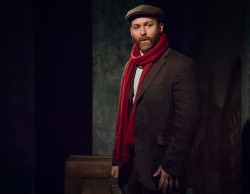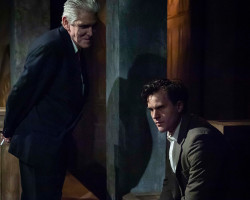
Beate Hein Bennett
|
Between a Rock and a Hard
Place
November 9 to December 9, 2018 The times, they may seem to be “a-changing” but as one takes a wider and longer view of human history, much remains the same: the longing for harmony while engaging in war; old political hacks gleefully sending the young off to war; the young spouting ideological utopias that end in conflict, resentment, or resignation. Revolution, Change, Progress? Who are the winners in the game for power and dominance? And whose history is written by whom?
Robert Ardrey’s play, “Shadow of Heroes” is a documentary drama about the political struggles in Hungary, beginning in the last phase of WWII, 1944-45 and ending with the 1956 abortive revolution. During the fall of 1956 Robert Ardrey (1908-1980) was in Vienna witnessing the brutal Soviet subjugation of the Hungarian uprising. He wrote the play in 1958 using real historical characters and facts as they emerged; the play premiered in London in 1958 and was produced in New York in 1961. Ardrey was born and raised on the Southside of Chicago. Having lived through the Great Depression, he was propelled to become a writer, sensitive to political and social issues. As a young playwright he was mentored by Thornton Wilder who was influenced by Bertolt Brecht and the Living Newspaper theatre. This shows in the structure of “Shadow of Heroes” where the “Author”, a stage manager type, sets the scenes as they unfold. While the 1956 Hungarian Revolution seems far removed from our present time, the play’s central issues go beyond the original historical context. The drama of power politics, party loyalty and sycophancy, and betrayal resonates loudly in the Trumpian universe of US politics with the social, moral, and human cost exacted by such politics. The play follows the trajectory and conflicts of five historical figures central to the history of Hungarian communist politics: the “old guard communists” Laszlo and Julia Rajk and Janos Kadar versus Ernö Gerö and Matyas Rakosi, the “elite” party emissaries from Moscow who are charged with imposing Stalin’s will on the Hungarians. Laszlo Rajk is a young idealistic fighter who has managed to evade the Gestapo and is considered the brain and strategist of the local communist party; Julia is a young communist who has taken on the dangerous work of running messages between the communist underground cells, trying to evade repressive police and the Gestapo. Janos Kadar, a true working class communist who fought in the Spanish Civil War, is close friend to the Rajks. The question of political self-sacrifice, betrayal, and going from delusion to disillusion is played out among those three.
The superb acting of Erin Beirnard as Julia compresses the entire tragedy of millions of victims of political expediency and betrayal into a two hour performance. Trevor St. John-Gilbert plays her husband Laszlo Rajk—it is a physical tour de force—as he goes from self-confident idealistic activist to tortured victim who provides a false confession for the sake of presumed party unity—a replay of Stalin’s 1938 purges. Michael Turner’s Janos Kadar is a study in the gradual moral disintegration for personal political gain and security—he gives this ultimately despicable figure an undertone of tragic confusion; he realizes too late the gravity of his sin of betrayal. Ernö Gerö, played by a towering David Logan Rankin, and Matyas Rakosi, played by a suave Zenon Zeleniuch, represent the Soviet party elite. Both are Hungarians who lived outside of the country for much of their careers and obviously managed to survive (so far) Stalin’s paranoia. Rakosi is polyglot, elegant, educated, obviously an upper bourgeois convert to the cause—full of cynical irony and sarcasm, deliciously rendered by Zeleniuch. Gerö is the heavy politruk/apparatchik—elegantly suited up, chain smoking, strident and nervous—Rankin gives him a dangerous brutal edge, slightly awkward, without light in his dark eyes. The Author introduces the characters and connects all the parts in the play. It is a formidable task which keeps the episodes moving. Joel Rainwater’s matter-of-fact delivery maintains this distancing effect; like a stage manager he helps the cast to move the neutral packing-crate like set pieces and explains time and place to the audience. Thirty characters are played by eleven actors who perform several characters (except for Joel Rainwater, Erin Beirnard, and Michael Turner). They are working like a smooth engine coming onto and into each scene fully engaged in their persona, whether as torturer, police, party operative, various women, or even as other famous historical figures, e. g. Mikoyan, Andropov, and Imre Nagy. Director Alex Roe keeps the action moving with pace and clarity in the small performance space, designed ingeniously by Vincent Gunn, who provides hiding spots and suggestions of interior and exterior spaces. The audience sits on three sides, very close to the action in this intimate space. The focused lighting by Jessie Lynn Smith and period suggestive costumes by Sidney Fortner maintain the ambience of the play. The sound design of Bill Toles suggests off-stage events; the pre-set music is soft Hungarian cimbalom. I was struck by how well Robert Ardrey was able to render already in 1958 the intra-party machinations and cynicism with which the communists climbed over each other’s political (and real) corpses. Then a friend reminded me about Arthur Koestler’s novel “Darkness at Noon,” inspired by the 1938 Moscow trials and purges under Stalin and written in 1939/40 in Paris on the eve of France’s capitulation to Nazi Germany. The book was published in London in 1940 and immediately widely circulated, including in the US. The novel depicts precisely these machinations. (Interestingly, in 2015 a typescript of the novel in the original German, thought to have been lost, was discovered in Switzerland.) Koestler wrote in 1939 what resonates now: “Every jump of technological progress leaves the relative intellectual development of the masses a step behind and thus causes a fall in the political maturity thermometer. It takes sometimes tens of years, sometimes generations, for a people’s level of understanding gradually to adapt itself to the changed state of affairs, until it has recovered the same capacity for self-government as it had already possessed at a lower stage of civilization.” |
| museums | NYTW mail | recordings | coupons | publications | classified |



